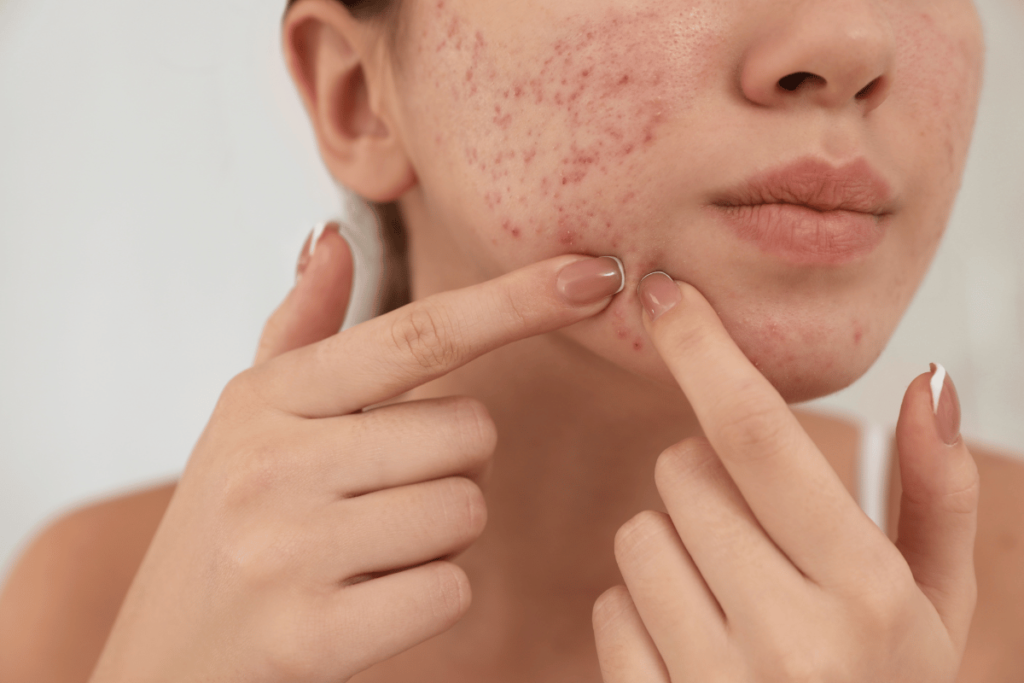
introduction
Pimple popping – Reading these words will probably make you satisfied or tremble. Some have found out that annoying Zit feels like a guilty pleasure, while others have no dreams of touching their beauty. But whether you’re a pimple popper or a hand type, the appeal of this ancient skincare residence cannot be denied.
It is important to understand the potential risks of pimple popping before reaching for this mirror and finger. What may seem like a harmless, quick solution can lead to scars, infections, and even long-term skin problems. On the other hand, if you did it right (yes, there is a real way), it can save you from a throbbing and inflamed outbreak.
This guide dives deep into everything you need to know about pimple popping- the do’s, dont’s, the hidden dangers, and solutions supported by experts that will make you rethink your approach. Once you’re done reading, you will be armed with enough knowledge to make informed decisions for your skin.
And here’s the real kicker: We’ll also reveal expert techniques on how to deal with blemishes without ever needing to pop them in the first place. So, whether you’re here to break the habit or learn the safest techniques, stick around for some game-changing skin insights.
Imagine clearer, healthier skin—and less of those frustrating red marks left behind by impulsive popping sessions. Ready to dive in? Let’s get
started.
Why Do We Love Popping Pimples? The Psychology Behind the Habit
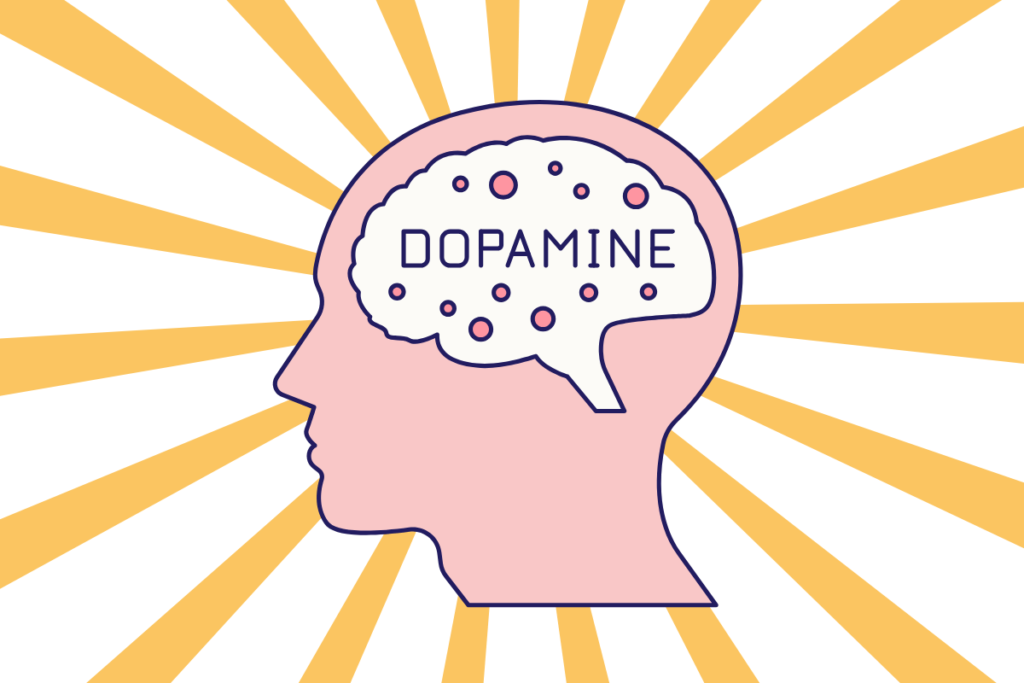
Let’s be real—there’s something oddly satisfying about pimple popping. Some people can’t resist the urge, while others find themselves glued to Dr. Pimple Popper videos, watching extractions like it’s the latest blockbuster. But why does pimple popping feel so good? Turns out, there’s real psychology behind this habit.
The Dopamine Rush: Why It Feels Rewarding
When you pop a pimple, your brain releases dopamine, the “feel-good” neurotransmitter associated with pleasure and reward. This mini dopamine hit makes pimple popping feel instantly gratifying, even though the long-term effects (like scarring and infection) are anything but rewarding.
It’s the same reason why people enjoy popping bubble wrap or picking at peeling paint—our brains love closure and completing tasks. And what’s more satisfying than seeing that little bump disappear before your eyes?
The Obsession with Skin Perfection
We live in a world that glorifies flawless skin, thanks to social media, filters, and airbrushed celebrity photos. This can make us hyper-aware of every little bump on our face, leading to an obsession with “fixing” imperfections.
For some, pimple popping becomes a compulsive behavior, where even the tiniest blemish must be dealt with—even if it means harming the skin in the process.
The Anxiety-Relief Connection
For many, popping pimples isn’t just about getting rid of blemishes—it’s a form of stress relief. The act of squeezing, pressing, and extracting can feel like a coping mechanism, providing a sense of control over an otherwise frustrating skin issue.
However, this can become a harmful habit, especially for those with dermatillomania (skin-picking disorder), where the urge to pick or pop leads to excessive skin damage and emotional distress.
Social Media’s Role: Are We Addicted to Watching It?
There’s a reason why millions of people binge-watch pimple popping videos—they trigger a mix of disgust and satisfaction, a psychological phenomenon known as “morbid curiosity.” Our brains are wired to be fascinated by things that are both repulsive and rewarding at the same time.
But watching these videos can also reinforce the urge to pop our own pimples, making it harder to break the habit.
The Science of Pimples: What’s Happening Under Your Skin?
To truly understand the risks of pimple popping, it’s important to first break down what a pimple actually is. Contrary to popular belief, a pimple isn’t just a tiny lump on your face—it’s a battle happening beneath your skin.
Pimples, also known as acne lesions, form when hair follicles (pores) become clogged with oil, dead skin cells, and bacteria. Your skin naturally produces sebum (oil) to keep it hydrated and healthy, but when there’s an overproduction—often due to hormonal changes, diet, stress, or genetics—it can mix with dead skin cells and create a sticky plug. This plug traps bacteria inside the pore, leading to inflammation.
There are different types of pimples, and each has its own unique challenges:
- Whiteheads (Closed Comedones): Small, flesh-colored or white bumps that occur when a pore is clogged but remains closed at the surface.
- Blackheads (Open Comedones): These occur when a clogged pore remains open, allowing oxidation to turn the trapped debris dark.
- Papules: Red, inflamed bumps that develop when clogged pores become irritated.
- Pustules: These are papules that have formed a white or yellow pus-filled head due to infection.
- Nodules & Cysts: Severe forms of acne that develop deep under the skin, often painful and prone to scarring.
So, why do some pimples have a “pop-worthy” head while others don’t? It all comes down to their stage of development. While whiteheads and pustules have a surface-level pocket of pus, deep nodules and cysts form much lower in the skin, making them far riskier to extract without professional help.
By understanding what’s happening beneath your skin, you can make more informed choices about whether or not to squeeze. Spoiler alert: Most of the time, it’s best to leave it alone.
The Immediate and Long-Term Risks of Pimple Popping
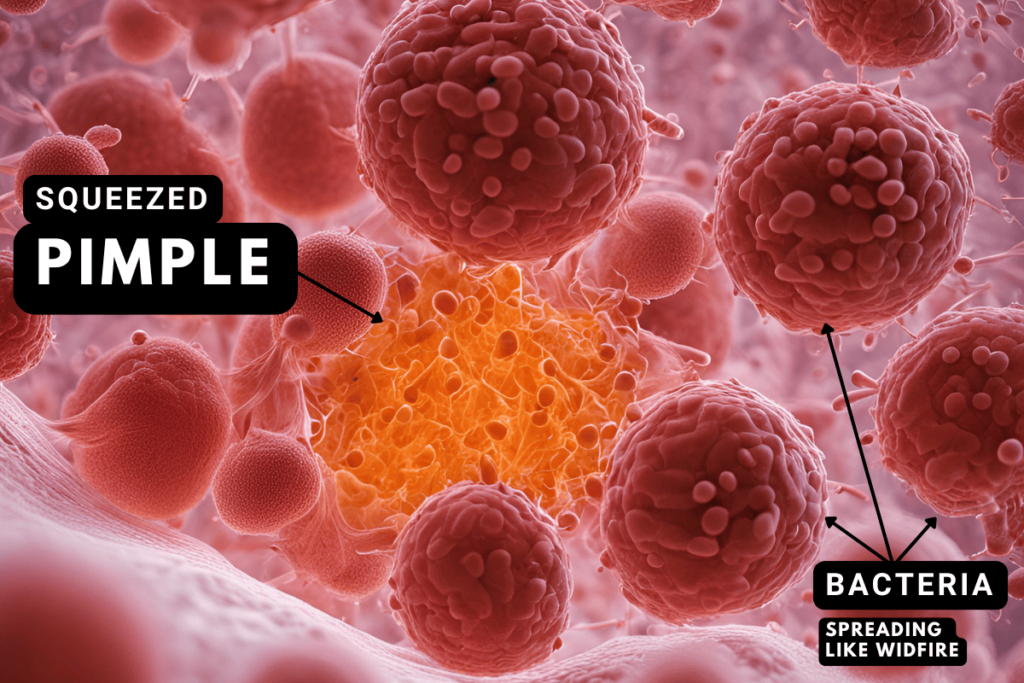
Pimple popping might seem like an easy fix, but the risks far outweigh the momentary satisfaction. From immediate damage to long-term consequences, here’s what can happen when you squeeze without caution.
Immediate Risks: What Happens Right After You Pop?
- Bacteria Spreading – The moment you pop a pimple, bacteria from your fingers and the surrounding skin can enter the open wound. This can lead to more breakouts and an increased risk of infection.
- Inflammation and Redness – Pimple popping forces the skin to break, causing irritation, swelling, and redness that lasts far longer than the pimple itself.
- Pushing Bacteria Deeper – Instead of fully extracting the pus, improper popping can push bacteria deeper into the pore, creating an even bigger and more painful pimple.
- Bleeding and Crusting – Pimple popping often bleeds, leading to scabs that take days or even weeks to heal, sometimes leaving hyperpigmentation behind.
- Pain and Discomfort – Squeezing an inflamed pimple can be painful, especially if it’s not ready to be extracted.
Long-Term Risks: The Damage You Can’t Immediately See
- Acne Scarring – One of the biggest dangers of pimple popping is permanent scarring. When the skin is forcefully ruptured, it can cause deep tissue damage, leading to pitted or raised scars.
- Hyperpigmentation (Dark Spots) – Even if a pimple doesn’t scar, it can leave dark marks (post-inflammatory hyperpigmentation), which take months to fade.
- Weakened Skin Barrier – Constantly picking at your skin can weaken its natural defense, making it more susceptible to environmental damage and future breakouts.
- Delayed Healing – A pimple that might have gone away in a few days can take weeks to heal if pimple popping is done incorrectly.
- Increased Sensitivity – Damaged skin from picking can become more sensitive to skincare products, causing irritation and flare-ups.
So, is pimple popping ever okay? The short answer is: Only under specific conditions and done the right way. Otherwise, the risks far outweigh the benefits.
The Hidden Dangers of Pimple Popping
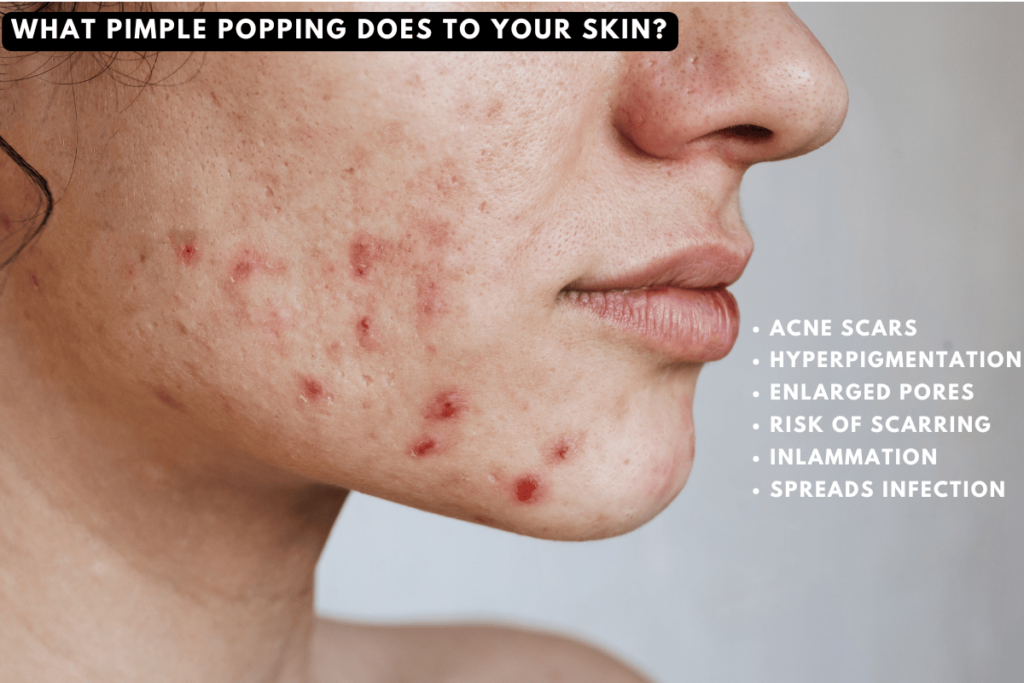
If you’ve ever done pimple popping and ended up with a red, angry mark that stuck around longer than the zit itself, you already know the immediate downside of this habit. But the risks of pimple popping go far beyond temporary redness—it can lead to serious, long-term damage that might not be worth the few seconds of satisfaction.
1. Scarring: The Unwanted Souvenir
One of the biggest risks of pimple popping is scarring. When you squeeze a pimple, you’re damaging the skin tissue, sometimes causing trauma deep within the layers of your skin. The more force you use, the higher the chance of collagen breakdown, leading to depressed or raised scars.
- Depressed scars (atrophic scars): These look like small dents or craters in the skin and can be tough to treat.
- Raised scars (hypertrophic scars): These happen when the skin produces too much collagen, leaving behind thick, raised marks.
If you’ve ever done pimple popping and noticed dark spots that linger for weeks or months, that’s post-inflammatory hyperpigmentation (PIH)—another unwanted consequence.
2. Infection: Making It Worse Instead of Better
Pimples are already full of bacteria, and when you pop them with your fingers (or worse, dirty tools), you’re introducing even more bacteria into the open wound. This can cause:
- Worsening inflammation—turning a small pimple into a larger, more painful breakout
- New breakouts nearby, as bacteria spreads to surrounding pores
- Painful cystic acne if the infection goes deeper into the skin
The worst-case scenario? A serious skin infection, requiring antibiotics or even medical intervention.
3. The “Pimple Triangle” Danger
Ever heard of the “triangle of death” on your face? It’s the area between your nose bridge and the corners of your mouth, where veins are directly connected to your brain’s blood supply.
Popping a pimple in this area can lead to serious infections, potentially causing:
- Cellulitis (a deep skin infection)
- Blood clots in the brain
- Meningitis (a life-threatening brain infection)
While it’s rare, it’s definitely a real risk—one that makes avoiding pimple popping even more worth it.
4. Delayed Healing: The Zit That Never Ends
Popped pimples often take longer to heal than ones left alone. When you squeeze, you’re breaking the skin barrier, making it harder for your skin to recover quickly.
Instead of disappearing in a few days, a popped pimple can stick around for weeks—or worse, leave a permanent mark.
5. Skin Barrier Damage & Increased Sensitivity
Your skin is designed to protect you, but when you constantly pop pimples, you’re weakening your skin’s natural barrier. This can lead to:
- Increased sensitivity—skin becomes more reactive to products and environmental factors
- Dried Skin & irritation—as the barrier loses its ability to retain moisture
- Frequent breakouts—since a weakened barrier makes it easier for bacteria to invade
How to Resist the Urge to Pimple popping
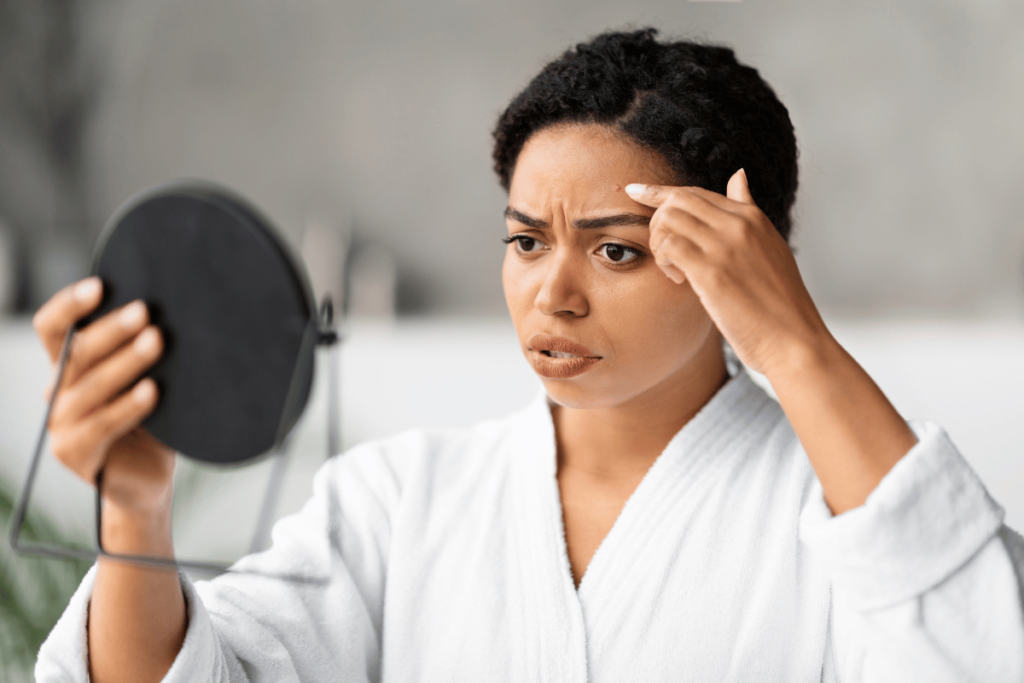
We get it—resisting the urge for pimple popping is like trying to ignore an itch. The temptation is real, especially when a whitehead is staring back at you in the mirror. But before you go in for the squeeze, here are some proven ways to keep your hands off your face and let your skin heal properly.
1. Keep Your Hands Busy (or Distracted!)
One of the biggest reasons why pimple popping is a habit—it’s something you do without thinking. Breaking that habit starts with keeping your hands busy so they don’t wander to your face. Try:
- Fidget toys—stress balls, fidget cubes, or even a pen to click
- Skincare-friendly distractions—like applying a cold compress instead
- Gentle tapping on your skin (instead of picking) to curb the urge
If your hands aren’t free to pick, your face stays safe.
2. Stand 3 Feet Away from the Mirror
Getting up close and personal with your mirror magnifies every imperfection, making a small pimple look like a giant red alarm. The best trick? Step back!
- Avoid magnifying mirrors—they make blemishes look worse than they are.
- Limit your bathroom mirror time—the less you stare, the less you’ll pick.
- Only check your skin in natural lighting—fluorescent lights exaggerate redness.
3. Use Pimple Patches for Instant Gratification
Pimple patches are lifesavers for habitual pimple popping experts! They:
✔ Cover the pimple, so you can’t touch it
✔ Suck out pus and gunk safely
✔ Speed up healing and reduce inflammation
If you find yourself constantly picking and continuing with pimple popping again, slap a hydrocolloid patch on and let it work its magic.
4. Remind Yourself of the Consequences
The next time you reach for a zit, to continue your pimple popping, stop and think:
- Will this make my pimple worse? (Probably.)
- Am I risking a scar? (Definitely.)
- Do I want to deal with hyperpigmentation for months? (Nope.)
A little mindfulness goes a long way in breaking the cycle.
5. Build a Better Skincare Routine
Instead of continuing with your pimple popping, focus on preventing them in the first place. Keep a solid routine with:
✔ Salicylic acid (to unclog pores)
✔ Benzoyl peroxide (to kill acne-causing bacteria)
✔ Retinoids (to speed up skin cell turnover)
✔ Moisturizer & SPF (to protect your skin barrier)
If your skin is happy and healthy, you’ll have way fewer temptations to pop.
When You Absolutely Shouldn’t Pop a Pimple?
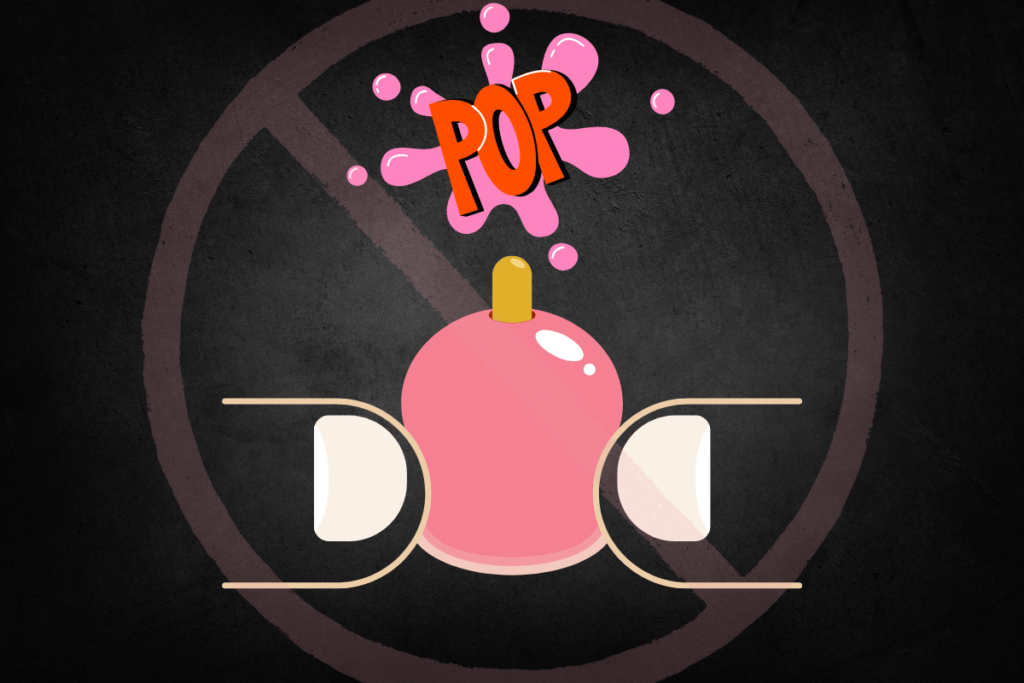
Not all pimples are created equal—some are more dangerous to pop than others. In fact, squeezing the wrong type of blemish can cause serious skin damage (or even health risks). Here’s when you should absolutely keep your hands off:
1. If It’s a Deep, Painful Cyst
Cystic acne isn’t just your typical zit—it’s a large, inflamed lump buried deep under the skin. Unlike whiteheads or blackheads, these pimples don’t have a visible opening to release trapped pus.
Popping a cyst means:
❌ Forcing bacteria deeper into the skin, making the infection worse
❌ Causing intense inflammation that leads to dark scars
❌ Risking serious infections, including cellulitis (a painful skin infection that may require antibiotics!)
✔ Instead, use ice packs and anti-inflammatory treatments to calm the swelling while letting your skin heal naturally.
2. If It’s in the “Triangle of Death” on Your Face
Sounds dramatic, but this is real. The area between your nose and upper lip is sometimes called the “danger triangle” because it contains blood vessels directly linked to your brain.
Popping a pimple here can:
⚠ Push bacteria into your bloodstream, leading to serious infections
⚠ Trigger swelling that spreads quickly
⚠ Increase the risk of dangerous complications, like cavernous sinus thrombosis (a rare but life-threatening condition)
✔ Instead, leave it alone or apply warm compresses to help it heal safely.
3. If the Pimple Has No Whitehead (Yet)
If there’s no visible pus, your pimple isn’t ready to pop. Attempting to force it will:
❌ Cause more inflammation and redness
❌ Push the infection deeper into your skin
❌ Extend the healing time, leaving you with a bigger, angrier pimple
✔ Instead, apply salicylic acid or pimple patches to help it resolve on its own.
4. If You Haven’t Washed Your Hands or Tools
Bacteria is everywhere—on your fingers, under your nails, and on your tweezers. If you pop a pimple without cleaning your hands, you’re inviting more bacteria into an already infected pore.
This can lead to:
❌ More pimples forming around the area
❌ Painful infections
❌ Slow healing time
✔ If you must pop a pimple (though we don’t recommend it), always use clean hands, sanitized tools, and antiseptic aftercare.
How to Treat Pimples Without Popping: Expert-Backed Solutions
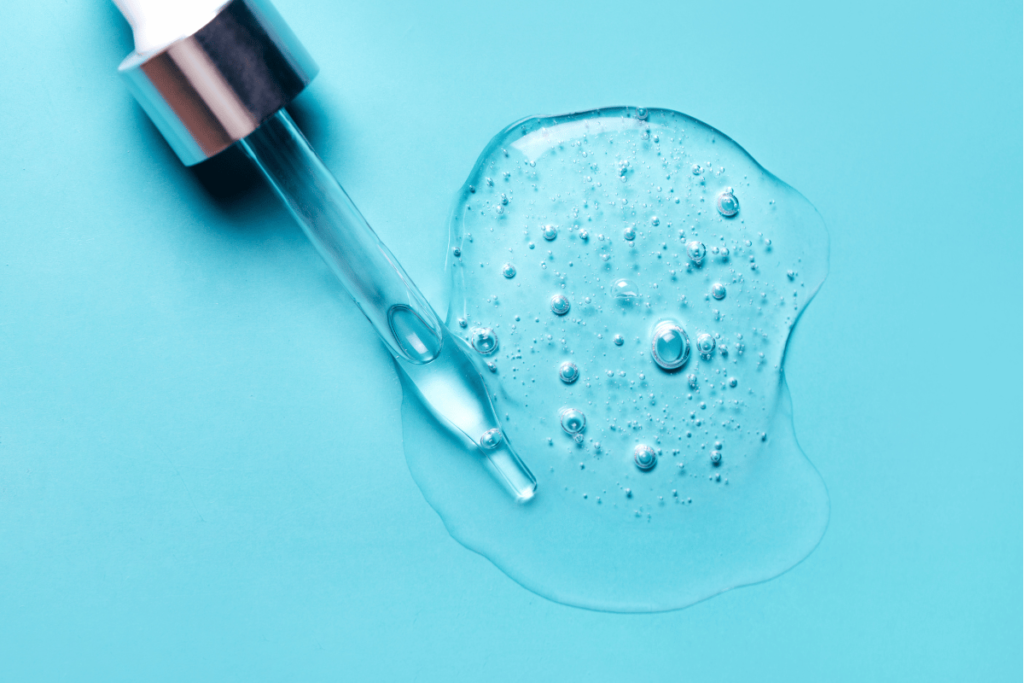
So, you’ve resisted the urge to pop (or at least, you’re trying to). But now you’re stuck wondering: What’s the best way to make a pimple disappear—without squeezing it? The good news? Dermatologists have proven methods that are not only safer but also far more effective than popping.
1. Spot Treatments That Actually Work
Instead of picking at your skin, reach for these derm-approved treatments to speed up the healing process:
✔ Salicylic Acid: This beta-hydroxy acid (BHA) penetrates deep into the pores and dissolves excess oil and dead skin cells, preventing future breakouts.
✔ Benzoyl Peroxide: An antibacterial powerhouse that kills acne-causing bacteria and reduces inflammation.
✔ Sulfur-Based Treatments: Helps dry out the pimple and absorb excess oil without over-irritating the skin.
✔ Retinoids: Speeds up cell turnover, helping the skin shed clogged pores faster.
💡 Pro Tip: Look for overnight acne patches with hydrocolloid to draw out impurities while protecting the pimple from further irritation.
2. Ice It Like a Pro
If your pimple is red and inflamed, apply an ice cube wrapped in a clean cloth for about 5-10 minutes. This helps:
✔ Reduce swelling
✔ Minimize redness
✔ Numb any pain
💡 Pro Tip: Follow up with an anti-inflammatory ingredient like green tea extract or aloe vera gel to soothe the skin.
3. The Power of Clay Masks
Clay masks, especially those containing kaolin or bentonite, absorb excess oil and detoxify the skin without harsh irritation. Using a clay mask 2-3 times a week can help prevent new breakouts while gently drying out existing pimples.
4. Tea Tree Oil – Nature’s Acne Fighter
A natural alternative to benzoyl peroxide, tea tree oil has antibacterial and anti-inflammatory properties. Studies show that a 5% tea tree oil solution is just as effective as benzoyl peroxide in treating mild acne.
💡 How to Use: Dilute one drop of tea tree oil in a carrier oil (like jojoba or rosehip oil) and apply it directly to the pimple using a cotton swab.
5. Hydration is Key – Even for Oily Skin
Dehydrated skin overproduces oil, which can lead to more breakouts. Using a lightweight, non-comedogenic moisturizer with hyaluronic acid helps keep skin balanced and less prone to pimples.
💡 Pro Tip: Don’t skip SPF! Sun exposure can cause post-inflammatory hyperpigmentation (dark spots) and worsen acne scars. Choose a sunscreen labeled “oil-free” and “non-comedogenic.”
When to Seek Professional Help for Pimples
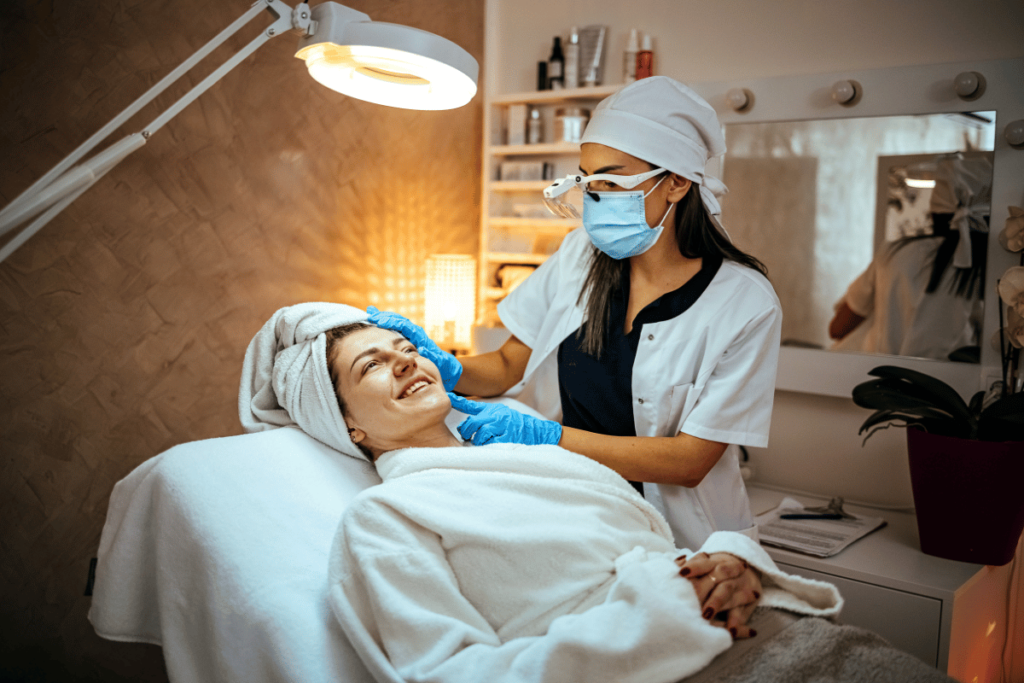
While many breakouts can be managed with over-the-counter treatments and home remedies, some cases require a dermatologist’s expertise. Knowing when to seek professional help can make the difference between clear skin and long-term acne scars.
1. Your Breakouts Are Severe or Painful
If you’re dealing with deep, painful cystic acne, over-the-counter treatments may not be enough. Cystic acne occurs deep within the skin, making it difficult to treat with surface-level products. Left untreated, it can lead to permanent scarring.
💡 Signs You Need a Dermatologist:
✔ Large, painful nodules or cysts under the skin
✔ Frequent breakouts that don’t respond to OTC treatments
✔ Acne that leaves behind dark spots or scars
Potential Treatments: A dermatologist might prescribe oral antibiotics, hormonal treatments, or isotretinoin (Accutane) for severe cases.
2. You’re Experiencing Post-Acne Scarring or Hyperpigmentation
Picking at your pimples increases the risk of scars and stubborn dark spots. If your skin isn’t healing properly or you’re noticing lasting marks, professional treatments can help fade discoloration and improve skin texture.
✔ Chemical Peels: AHA or BHA-based treatments to exfoliate and speed up skin renewal.
✔ Laser Therapy: Targets deep scars and pigmentation for smoother skin.
✔ Microneedling: Uses tiny needles to stimulate collagen production and reduce scarring.
💡 Pro Tip: The earlier you address scarring, the better your chances of achieving clear, even-toned skin.
3. You’re Battling Adult Acne
Think pimples are just for teenagers? Think again. Hormonal acne in adults is incredibly common, especially in women. If you’re noticing:
✔ Breakouts around the jawline and chin
✔ Acne flare-ups during certain times of your menstrual cycle
✔ Stress-related or lifestyle-induced acne
…it’s time to consult a dermatologist. Treatments like birth control pills, spironolactone, or specialized topical creams can help balance hormones and clear breakouts.
4. You’ve Tried Everything, but Nothing Works
If your acne is persistent despite trying multiple treatments, diet changes, and skincare routines, it may be time to consult a professional. A dermatologist can assess underlying causes, such as:
✔ Hormonal imbalances
✔ Dietary triggers
✔ Skin conditions that mimic acne (like fungal acne)
They can then create a customized treatment plan that actually works for your unique skin.
The Final Verdict on Pimple Popping…
“Your skin is not a battlefield, and your fingers are not warriors. Let healing happen in silence, without the scars of impatience.”
-Handcrafted Skin
So, after diving deep into the world of pimple popping —what’s the takeaway? While the satisfaction of squeezing a pesky zit might feel like an instant win, the long-term risks can far outweigh the temporary relief. From scarring to infections and even more breakouts, pimple popping is a slippery slope that could leave you regretting that quick squeeze.
That said, we get it—resisting the urge can feel nearly impossible. If you absolutely must pop a pimple, make sure you follow safe extraction techniques (clean hands, sterilized tools, and a light touch), and do not continue pimple popping as a habit. But honestly, the safest and smartest move is to let your skin heal naturally or seek expert guidance. Dermatologists have a treasure trove of treatments that can help you combat acne without leaving a battlefield of scars behind.
At the end of the day, your skin deserves love and patience—not aggressive pimple popping in front of a magnifying mirror. The real glow-up comes from a solid skincare routine, proper hydration, a healthy diet, and stress management. So, next time you’re tempted do your pimple popping, take a deep breath, step away from the mirror, and remind yourself: clear skin is a marathon, not a sprint!
